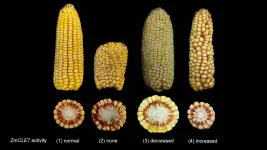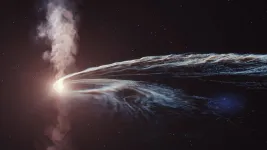(Press-News.org) By analyzing 50 years' worth of coral reef biodiversity studies, researchers reporting in the journal Current Biology on February 22 have quantified the practice of "parachute science," which happens when international scientists, typically from higher-income countries, conduct field studies in another, typically lower-income country, without engaging with local researchers. They found that institutions from several lower-middle- and upper-middle-income countries with abundant coral reefs produced less research than institutions based in high-income countries with fewer or in some cases no reefs. They also found that host-nation scientists (scientists from the nations where field research was conducted) were not included in authorship on studies almost twice as often when those studies were conducted in lower-income countries.
"Unfortunately, for decades, it was the norm for researchers from high-income nations and wealthy institutions to engage in parachute science practices and build successful academic careers because of that. It's only recently that people started discussing about unfair research practices in marine science," says first author Paris Stefanoudis (@paris_st_v), a postdoctoral researcher in zoology at Oxford University. "There wasn't any quantifiable evidence for it before now."
Part of the difficulty in quantifying parachute science is that it can take on a variety of different forms depending on the researchers and the country in question.
"As a person of color from a large ocean state, I've definitely experienced parachute science," says coauthor Sheena Talma (@sheena_talma), who is the Science Program Manager at Nekton Foundation in the UK and is from the Seychelles. "Some researchers apply for funding and only approach the local scientists once they've already got their grant. I've also seen researchers only take on partners in the host country just to make getting a permit easier."
To identify trends in parachute science, the researchers analyzed publication metrics from the database Scopus for 50 years of warm-water coral reef biodiversity-related research. First, they looked at which countries were publishing these studies around the world and compared this to the amount of coral reef habitat in each of those countries.
"One thing that was notable was that of the top ten countries with the most reef publications, only two were not high-income nations--and two of them (Canada and Germany) don't have any coral reefs at all," says Stefanoudis. "That is a clear example of Western intellectual colonialism regarding an ecosystem that is predominantly affecting people's lives in the tropics."
Another sign of parachute science is when a coral reef study conducted in a certain country does not include any authors from that country. The researchers found that to be the case in 22% of studies conducted in Australia. But the effect was even more pronounced when the country where the fieldwork took place was lower income: studies in lower-income countries like Indonesia and the Philippines excluded local authors about 40% of the time. The researchers found a similar pattern when it came to research leadership (defined as publications where the first and/or senior author was from the host nation), with two-thirds of Australian studies led by Australian researchers, but only approximately 30% of Indonesian and 40% of Philippine studies led by local scientists.
"Parachute science is clearly still widespread in marine science, but it benefits nobody in the long run," says Stefanoudis. "For researchers in host nations, it creates and perpetuates dependency on external expertise and hinders local research efforts. But for scientists conducting research overseas too, ineffective collaborations and unbalanced partnerships exclude them from a wealth of knowledge and practical skills that host nation scientists have. Thus, true and meaningful collaborations should be actively encouraged and not seen as a tick-boxing exercise.
While parachute science is difficult to combat due to its massive historical legacy often linked to colonialism, the researchers provide a list of suggestions for scientists conducting research in other countries, including liaising with local governments, co-designing a research agenda with host nation researchers and stakeholders, partnering with early-career researchers, and sharing data to promote knowledge exchange. However, they also hope that their work will lay a foundation for more detailed guidelines for academic, research, and funding institutions to eradicate parachute science practices in the future.
"Parachute science is complex, multilayered, and historical. The solution is not only about including more local scientists in publications, but about building relationships, developing knowledge-exchange activities, and having mutual trust and respect between all parties," says Talma. "Local scientists have a lot to offer foreign researchers, and building those partnerships enables skill sharing and empowers people on the ground to continue the work once the foreign scientists leave."
INFORMATION:
This study was the result of the collaboration between researchers based in the UK, Seychelles, Philippines, Australia, and Fiji. Funding was provided by the Nekton Foundation.
Current Biology, Stefanoudis et al.: "Turning the tide of parachute science" https://www.cell.com/current-biology/fulltext/S0960-9822(21)00062-2
Current Biology (@CurrentBiology), published by Cell Press, is a bimonthly journal that features papers across all areas of biology. Current Biology strives to foster communication across fields of biology, both by publishing important findings of general interest and through highly accessible front matter for non-specialists. Visit: http://www.cell.com/current-biology. To receive Cell Press media alerts, contact press@cell.com.
Corn--or maize--has changed over thousands of years from weedy plants that make ears with less than a dozen kernels to the cobs packed with hundreds of juicy kernels that we see on farms today. Powerful DNA-editing techniques such as CRISPR can speed up that process. Cold Spring Harbor Laboratory (CSHL) Professor David Jackson and his postdoctoral fellow Lei Liu collaborated with University of Massachusetts Amherst Associate Professor Madelaine Bartlett to use this highly specific technique to tinker with corn kernel numbers. Jackson's lab is one of the first to apply CRISPR to corn's very complex ...
Tracing back a ghostly particle to a shredded star, scientists have uncovered a gigantic cosmic particle accelerator. The subatomic particle, called a neutrino, was hurled towards Earth after the doomed star came too close to the supermassive black hole at the centre of its home galaxy and was ripped apart by the black hole's colossal gravity. It is the first particle that can be traced back to such a 'tidal disruption event' (TDE) and provides evidence that these little understood cosmic catastrophes can be powerful natural particle accelerators, as the team led by DESY scientist Robert Stein reports in the journal Nature Astronomy. The observations also demonstrate the power of exploring the cosmos via ...
A new study from UCLA and Stanford University researchers finds that three-dimensional human stem cell-derived 'mini brain' organoids can mature in a manner that is strikingly similar to human brain development.
For the new study, published in Nature Neuroscience February 22, senior authors Dr. Daniel Geschwind of UCLA and Dr. Sergiu Pasca of Stanford University conducted extensive genetic analysis of organoids that had been grown for up to 20 months in a lab dish. They found that these 3D organoids follow an internal clock that guides their maturation in sync with the timeline of human development.
"This is novel -- Until now, nobody has grown and characterized these organoids for this amount of time, nor shown they will recapitulate human brain development in a laboratory environment ...
A two-metre-long painting of a kangaroo in Western Australia's Kimberley region has been identified as Australia's oldest intact rock painting.
Using the radiocarbon dating of 27 mud wasp nests, collected from over and under 16 similar paintings, a University of Melbourne collaboration has put the painting at 17,500 and 17,100 years old.
"This makes the painting Australia's oldest known in-situ painting," said Postdoctoral Researcher Dr Damien Finch who pioneered the exciting new radiocarbon technique.
"This is a significant find as through these initial estimates, we can understand something of the ...
What The Study Did: Using COVID-19 data, this observational study looked at what are the independent associations of voluntary behavioral change and legal restrictions, such as state-mandated school closings, with the subsequent spread of the COVID-19 pandemic in the U.S.
Authors: Frederick J. Zimmerman, Ph.D., of the Fielding School of Public Health at UCLA in Los Angeles, is the corresponding author.
To access the embargoed study: Visit our For The Media website at this link https://media.jamanetwork.com/
(doi:10.1001/jamapediatrics.2020.6371)
Editor's Note: The article includes ...
A team of scientists has detected the presence of a high-energy neutrino--a particularly elusive particle--in the wake of a star's destruction as it is consumed by a black hole. This discovery, reported in the journal Nature Astronomy, sheds new light on the origins of Ultrahigh Energy Cosmic Rays--the highest energy particles in the Universe.
The work, which included researchers from more than two dozen institutions, including New York University and Germany's DESY research center, focused on neutrinos--subatomic particles that are produced on Earth only in powerful ...
What The Study Did: Researchers examined changes in trauma admissions throughout Los Angeles County during the COVID-19 pandemic in California.
Authors: Kazuhide Matsushima, M.D., of the University of Southern California in Los Angeles, is the corresponding author.
To access the embargoed study: Visit our For The Media website at this link https://media.jamanetwork.com/
(doi:10.1001/jamanetworkopen.2021.1320)
Editor's Note: The article includes funding/support disclosures. Please see the article for additional information, including other authors, author contributions and affiliations, conflict of interest and financial disclosures, ...
Scientists at the University of Groningen (The Netherlands), in collaboration with colleagues from the University of Torino (Italy), have developed a method to visualize and quantify alternative structures of RNA molecules. These alternative RNA 'shapes' can have important functional relevance in viruses and bacteria. The researchers used an algorithm to rapidly analyse large quantities of chemically modified RNA molecules and calculate how many differently folded conformations were present. This technique was used to identify a conserved structural switch in the ...
What The Article Says: How parents can identify whether their teens are vaping, how to help prevent it, and what to do if their teen is addicted are discussed in this JAMA Pediatrics Patient Page.
To access the embargoed study: Visit our For The Media website at this link https://media.jamanetwork.com/
(doi:10.1001/jamapediatrics.2020.6689)
Editor's Note: Please see the article for additional information, including other authors, author contributions and affiliations, conflict of interest and financial disclosures, and funding and support.
INFORMATION:
Media advisory: The full article is linked to this news release.
Embed this link to provide your readers free access to the full-text article This link will be live at the embargo time https://jamanetwork.com/journals/jamapediatrics/fullarticle/10.1001/jamapediatrics.2020.6689?guestAccessKey=8fe3a04c-4e0a-40f3-a883-916eaadb05bb&utm_source=For_The_Media&utm_medium=referral&utm_campaign=ftm_links&utm_content=tfl&utm_term=022221
...
What The Study Did: This survey study looked at changes in abortion policies among states by examining legislation enacted between January 2017 and November 2020.
Authors: Phillip M. Singer, Ph.D., of the University of Utah in Salt Lake City, is the corresponding author.
To access the embargoed study: Visit our For The Media website at this link https://media.jamanetwork.com/
(doi:10.1001/jamainternmed.2020.8781)
Editor's Note: Please see the article for additional information, including other authors, author contributions and affiliations, conflict of interest and financial disclosures, and funding ...



